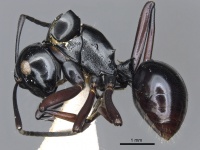Polyrhachis linae
| Polyrhachis linae | |
|---|---|

| |
| Scientific classification | |
| Kingdom: | Animalia |
| Phylum: | Arthropoda |
| Class: | Insecta |
| Order: | Hymenoptera |
| Family: | Formicidae |
| Subfamily: | Formicinae |
| Tribe: | Camponotini |
| Genus: | Polyrhachis |
| Subgenus: | Cyrtomyrma |
| Species: | P. linae |
| Binomial name | |
| Polyrhachis linae Donisthorpe, 1938 | |
Nothing has been published about the biology of Polyrhachis linae.
Identification
Polyrhachis linae is somewhat simlar to Polyrhachis debilis, but it differs by its larger size and more steeply convex pronotum that is widest just behind the narrowly rounded humeri. The propodeal spines are short, but distinct. In contrast, specimens of Polyrhachis debilis are distinctly smaller with a weakly convex pronotal profile. The pronotal humeri are widely rounded and the propodeal spines very short, present as tuberculae or completely absent. (Kohout 2006)
Keys including this Species
Distribution
From Kohout (2006): Polyrhachis linae appears to be a rather uncommon, but widespread, New Guinean species with several colonies collected recently by R. Snelling at the Lakekamu Basin (Gulf Prov., Papua New Guinea).
Latitudinal Distribution Pattern
Latitudinal Range: -3.324166667° to -3.324166667°.
| North Temperate |
North Subtropical |
Tropical | South Subtropical |
South Temperate |
- Source: AntMaps
Distribution based on Regional Taxon Lists
Indo-Australian Region: New Guinea (type locality).
Distribution based on AntMaps
Distribution based on AntWeb specimens
Check data from AntWeb
Countries Occupied
| Number of countries occupied by this species based on AntWiki Regional Taxon Lists. In general, fewer countries occupied indicates a narrower range, while more countries indicates a more widespread species. |

|
Estimated Abundance
| Relative abundance based on number of AntMaps records per species (this species within the purple bar). Fewer records (to the left) indicates a less abundant/encountered species while more records (to the right) indicates more abundant/encountered species. |

|
Biology
Castes
Nomenclature
The following information is derived from Barry Bolton's Online Catalogue of the Ants of the World.
- linae. Polyrhachis (Cyrtomyrma) linae Donisthorpe, 1938c: 262, fig. 12 (w.q.) NEW GUINEA. See also: Kohout, 2006b: 131.
Unless otherwise noted the text for the remainder of this section is reported from the publication that includes the original description.
Description
Worker
Black, shining; legs dark brown, anterior tibial lighter, antennal, coxae, and tarsi black, palpi yellow, claws red. Usual reticulation and small scattered punctures, but the epimera of thorax and base of front of scale almost rugosely punctured, the anterior portion of the latter transversely striate.
Head transverse posteriorly, posterior angles distinct; mandibles finely punctured and longitudinally striate, the punctures large near the teeth, furnished with sharp teeth, the small tooth at the corners of the slightly projecting anterior margin of clypeus small, but: sharp and distinct. Thorax convex, anterior angles of pronotum rounded, broadest a little before the centre; pro-mesonotaZ suture well marked, meso-epinotal suture faintly indicated; epinotum armed with two short sharp spines projecting outwards and upwards; the declivity of the epinotum is somewhat abrupt and about as long as the anterior surface; scale armed with four short teeth of about equal length, the centre ones nearer to each other than to the lateral ones.
Long. 6·2 mm.
Queen
Similar to worker, puncturation of head stronger; spines on epinotum and scale blunter. Wings dusky; pterostigma and veins yellow.
Long. 7·6 mm.
Male
Type Material
Syntype workers, queens The Natural History Museum and Queensland Museum – as reported by Kohout (2006).
Type Locality Information
NEW GUINEA, Cyclops Mts, Mt Lina, 3500 ft. Five workers and three winged females taken by Miss L. E. Cheesman, February 1936.
References
- Donisthorpe, H. 1938c. The subgenus Cyrtomyrma Forel of Polyrhachis Smith, and descriptions of new species, etc. Ann. Mag. Nat. Hist. 11(1): 246-267 (page 262, fig. 12 worker, queen described)
- Kohout, R. J. 2006. Review of Polyrhachis (Cyrtomyrma) Forel (Hymenoptera: Formicidae: Formicinae) of Australia, Borneo, New Guinea and the Solomon Islands with descriptions of new species. Memoirs of the Queensland Museum. 52:87-146.
References based on Global Ant Biodiversity Informatics
- Janda M., G. D. Alpert, M. L. Borowiec, E. P. Economo, P. Klimes, E. Sarnat, and S. O. Shattuck. 2011. Cheklist of ants described and recorded from New Guinea and associated islands. Available on http://www.newguineants.org/. Accessed on 24th Feb. 2011.
- Kohout R.J. 2006. Review of Polyrhachis (Cyrtomyrma) Forel of Australia, Borneo, New Guinea and the Solomon Islands with descriptions of new species. Memoirs of the Queensland Museum 52: 87-146.
- Snelling R. R. 2000. Ants of the Wapoga river area, Irian Jaya, Indonesia. In Mack, Andrew L. and Leeanne E. Alonso (eds.). 2000. A Biological Assessment of the Wapoga River Area of Northwestern Irian Jaya, Indonesia. RAP Bulletin of Biological Assessment 14, Conservation International, Washington, DC.

